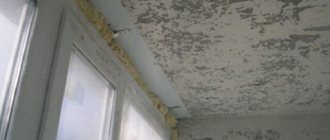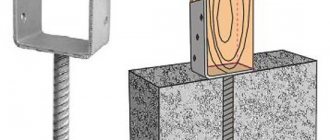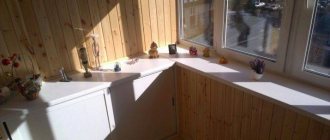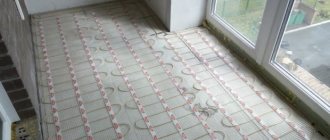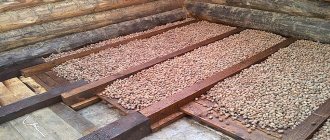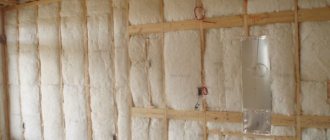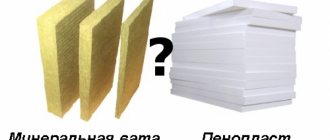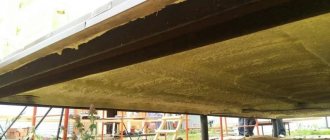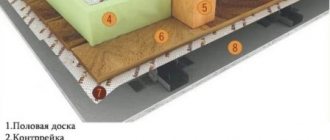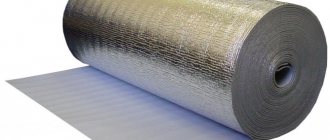What is façade glazing of a balcony?
This term refers to finishing the facade with glass material. To save money, developers make cold loggias . This is done to prevent precipitation and wind from entering this part of the housing. To make the use of balconies comfortable, apartment decide to glaze and insulate the loggia with a material suitable for arranging the facade.
Figure 1. Insulated balcony.
Advantages and disadvantages of external insulation
Insulation of balcony structures has a number of advantages:
- increase in usable area - you can arrange an additional room on a warm balcony;
- increased level of comfort;
- reduction in electricity costs due to high light transmission;
- pleasant aesthetic appearance;
- durable glazing reduces the possibility of unauthorized persons entering the apartment.
Glazing and insulation have disadvantages:
- reducing the area of the loggia;
- in some new buildings it is prohibited to make changes to the outside of the building, which can lead to legal problems;
- replacing glass on the loggia will require additional financial costs;
- Poorly carried out work on insulating the loggia leads to the appearance of mold.
Legal aspect
Before insulating the balcony and reconstructing the facade, it is necessary to obtain permission from the Bureau of Technical Inventory (BTI). The absence of a document encouraging changes in the design of the building is a guarantee of fines and problems with the authorities. If the owner has not received consent from the authorities to change the front side of the house, the extreme measures that the BTI can take is to demand that the previous appearance be restored. This entails material expenses. In order to obtain approval from the authorities, you need to provide a list of documents, the collection of which does not guarantee a positive decision.
Before you begin replacing glass in multi-story buildings, you need to coordinate the event with the management company, since the work will be performed by industrial climbers.
Options for warm glazing without changing the facade
Insulation of cold facade glazing carried out using two methods, which have their own advantages and disadvantages. Among them are:
- system with insulated jumpers;
- replacing glass with plastic frames.
Glazing with insulated lintels
The entire scope of work is carried out without reducing the square footage of the room. Experts actually use 2 methods to change the cold glazing of a house without changing the facade of the building .
Figure 2. Procedure for insulating a wooden window.
The first technology is the temperature separation of built-in structures. For this purpose, polystyrene foam pads are used. Next, double-glazed windows are inserted into the warm frames. In this option, metal clamps and rubber shutters are used. They are securely fastened with self-tapping screws and covered with platbands or other materials.
When carrying out work, we recommend using the installation of auxiliary sashes equipped with structures that can be tilted and rotated. The technique provides for obtaining good insulation without changing the size of the frames.
The second option consists of 3 phases. First, existing systems are dismantled. Next, install thermal insulating inserts. For this purpose, it is recommended to use polymer gaskets with thermal insulation.
Plastic double-glazed windows are replacing aluminum shutters to increase the degree of protection of the home from external factors. The resulting system significantly reduces the size of the window opening with a change in the exterior of the facade.
Replacing glass with double glazing
Installing additional double-glazed windows slightly changes the dimensions of the internal space. First, the system is sealed. To significantly reduce heat loss, rubber seals are used.
After this, you need to order additional double-glazed windows, taking into account the sizes of the main ones. The second structure is mounted closely to the window to create a single complex. This allows you to install 2 rows of them in one window opening.
Figure 3. Replacement of double-glazed windows.
Any installation seams in the glazing contours are covered with bushings made of rubber, plastic or aluminum. It is possible to choose the color palette and shape of these devices, taking into account the texture and shade of the window systems. Correct installation allows the second circuit to have swinging doors. Replacing windows with double-glazed windows to insulate façade glazing has a number of advantages:
- the appearance of free space after installation;
- saving money;
- preventing heat loss when combining the room with the kitchen;
- obtaining an attractive exterior thanks to the decorative finishing of the building .
In case of complete replacement of the structure , the old double-glazed windows are dismantled. Instead, insulated double-glazed windows are installed, which reduce heat loss in the home.
The insulation of facade glazing of windows when replacing them with double-glazed windows puts a significant load on the building. Before this, you need to consult with specialists and obtain approval for the installation of the profile in the relevant structures. It is also necessary to make accurate calculations for installing frames.
Insulation with an additional circuit
Typically, this technique is used if there are load-bearing supports in the frame that cannot be dismantled. Carrying out using this technology requires careful calculations. You also need to obtain permission from specialists to install additional structures, since the heaviness and bulkiness of the circuit can create a high load on the foundation.
This method of insulation consists of installing a plastic frame with double-glazed windows that have the dimensions of the original ceiling. Installation of the second circuit is carried out to the main system. The resulting gaps are closed using strips and thermal insulation. This serves as an additional barrier , preventing outside noise from entering the home and heat loss.
Possible problems most often occur when opening the second sash frame from the first through the windows. Another significant disadvantage is the change in the square footage of the room.
Which material to choose
The effectiveness of the work done depends on the material that was chosen as insulation. The modern construction market offers a wide selection that can satisfy the most selective. When insulating the facade of a loggia or balcony, choose the following materials:
- penoplex, foam plastic;
- mineral wool;
- isolon;
- penofol.
Each of them has both advantages and disadvantages. Detailed information is given in the table.
| Material name | Heat transfer | Life time | Price |
| Penotex | 0,036 | 30 years | low |
| Styrofoam | 0,31 – 0,05 | 30 years | low |
| Min. cotton wool | 0,048 – 0,070 | 25 – 40 years | high |
| Izolon | 0,031 – 0,041 | 100 or more years | High |
| Penofol | 0,037 – 0,051 | 100 or more years | high |
Note to the table: the higher the thermal conductivity index, the smaller the thickness should be used during installation.
Expanded polystyrene and extruded polystyrene foam
These types of materials are among the leaders in frequency of use. The frequency of using polystyrene foam and expanded polystyrene when insulating a balcony is due to their low cost and good thermal conductivity.
Figure 2. Facade glazing of the balcony.
Polystyrene foam is a hardened foam material that retains heat due to the air content inside the pores. When choosing polystyrene foam for insulation, you need to pay attention to thickness and density. The optimal indicator for the first criterion is 5 cm. The higher the density, the stronger the warm layer.
Advantages:
- high thermal insulation qualities;
- low cost;
- long service life;
- absorbs moisture well;
- low labor intensity during installation;
- if chosen correctly, it has high strength;
- does not release toxins;
- no fungus develops inside the plate.
Has a number of disadvantages:
- ignites easily and burns well;
- does not allow air to pass through;
- transmits sound;
- instability to chemical finishing agents.
Extruded polystyrene foam has similar quality characteristics, but has another advantage. It lies in the fact that this material is more homogeneous. Due to this, low thermal conductivity is achieved. Manufacturers produce several varieties of penoplex, each of which is suitable for a specific type of work. To insulate loggias, it is best to use the “Comfort” series.
Other materials for thermal insulation
The closest competitor to polystyrene foam when insulating a cold balcony is basalt mineral wool. The popularity of this material is determined by its good characteristics:
- does not allow heat to pass through;
- does not absorb moisture;
- breathable material;
- resistant to fire;
- high strength;
- does not allow noise from the street to pass through;
- environmentally friendly material does not emit harmful substances;
- fungus does not multiply inside the mineral wool;
- It is possible to use chemicals for finishing.
Disadvantages include high cost and the need for additional protection during operation.
In order to insulate a loggia or balcony, penofol is often used: it is a foam material with an aluminum layer to reflect heat. It has good protection against low temperatures, moisture and noise. Its popularity is due to its versatility: there is no need to install several layers separately for thermal insulation, noise insulation and moisture protection. To improve the quality of thermal protection, complex use is necessary.
There is another material used for insulating balconies. In appearance, isolon resembles the previous material. It has advantages and disadvantages. Advantages of isolon:
- long service life;
- versatility of use;
- does not burn;
- resistance to temperature changes;
- flexibility facilitates easy styling;
- good thermal insulation and sound insulation properties.
Disadvantages include high cost, the need to follow instructions for use, and fragility.
Prices for replacing balcony glazing in Moscow
To find out the exact cost of replacing cold facade glazing with warm one, you need to take measurements of the object. Call our company's surveyor for free. The specialist will measure the openings, assess the scale and complexity of the work, and offer suitable solutions. During the work, we use original certified materials and strictly follow installation technologies. We provide a 2-year warranty on glazing.
| Service | Cost of work |
| Warm glazing (material + fasteners + installation), m2 | 6800 rub. |
| Glazing from floor to ceiling (material + fastening elements + installation), m2 | 6800 rub. |
Methods for insulating facade glazing
Insulation of facade glazing means carrying out work on thermal insulation of a balcony with the installation of a ventilated facade . Experts identify several methods that are used to insulate cold facade glazing:
- insulation of existing frames;
- installation of double-layer frames;
- replacement of double-glazed windows.
Each of them has its own characteristics and requires a certain algorithm of actions. When choosing a method, the technical side of the issue (possibility of application in a specific situation), safety, customer preferences, and material resources are taken into account.
Figure 3. Glazing replacement.
Installation of a plastic structure
This term refers to the glazing of a balcony with plastic windows . To perform such work, you need to adhere to a certain sequence: dismantling old window frames, installing plastic windows in a pre-assembled frame, eliminating cracks using construction foam, waterproofing. After checking the tightness, installation of the platbands is carried out. This is done for additional protection against low temperatures and to add aesthetics to the room.
| Advantages of the method | Flaws |
|
|
Additional circuit
Insulating the façade glazing of a loggia using a second circuit is appropriate in cases where dismantling the previous one is technically impossible. This term means the installation of a second absolutely identical structure. To carry out this type of insulation, it is necessary to obtain permission from the authorities, since the second circuit not only performs the function of thermal insulation , but doubles the pressure on the balcony slab and load-bearing structures of the building . This method has several disadvantages - inconvenience when opening, reduction in usable area.
Glazing replacement
This type of insulation is considered radical, as it requires the removal of previously installed wooden frames and loggia windows. After dismantling, double or triple glazing is installed. This method is effective because the new glazing does not allow cold air to pass through due to its tightness. In this case, it is possible to install heating devices, which allows you to make the loggia a full-fledged room. Insulation of walls, ceiling and floor will be required to prevent heat loss.
If the owners are going to choose a double-glazed window that differs from the architectural design of the entire house, then they will have to obtain permission from the authorities.
Installation of warm aluminum profile
The term “warm aluminum profile” refers to the presence of a polyamide insert in the middle of an aluminum structure. A cold profile does not have a heat-retaining layer. For this method of insulation, the cold balcony facade is replaced with an aluminum window profile , in the middle of which plastic elements are built in. This requires a 2nd or 3rd glazing. This type will be the optimal solution for southern latitudes and is not suitable for northern regions.
Figure 4. Insulated glazing of the balcony.
Installation of plastic windows
In this case, the old cold glazing is dismantled, the frames remain in place. Window blocks are installed on prepared frame structures . Before installing decorative cladding, it is necessary to check the tightness.
The use of warm plastic windows allows you to save the area of the loggia or balcony. The advantages of this method include low cost and low labor intensity.
Insulation of single frames
Provided that the previous frames are strong enough, a second layer of glazed frames is installed on the loggia to retain heat. Before installing the frame structures themselves, you need to make supports on which the second layer of glazing will be placed. The disadvantages of this type of window repair include high material costs and inconvenience in use.
Replacing cold façade glazing with warm one
The third method is the most radical. It consists of completely replacing the aluminum structure with a metal-plastic one. The aluminum frame is cut off and a regular plastic window is installed in its place. As in the first two cases, all cracks are hermetically sealed.
When choosing this method, you need to take into account the requirements for the decorative design of the facade. In order not to violate the integrity of the building's design, plastic structures should be the same color as aluminum ones. This insulation option is rarely used because it is the most expensive.
Insulation of a balcony with a brick parapet
Before making a decision on reconstruction and insulation of a balcony with a brick parapet, you need to coordinate your actions with the management company, which will determine the load for the balcony slab that it can withstand. After receiving permission and calculations, you need to check the condition of the brick parapet. If the balcony railing is outdated, it should be reinforced or completely dismantled. Without sufficient reinforcement, the parapet will not be able to support the weight of window structures.
Figure 5. Design of facade glazing.
The insulation of the parapet takes place in several stages:
- the layer closest to the parapet is a waterproofing layer (penofol or isolon);
- at the next stage, the sheathing is made, between the beams of which insulation is laid;
- To ensure tightness, the seams are filled with construction foam.
Strengthening the parapet
Before installing window frame structures, it is necessary to strengthen the parapet, since the mass of double-glazed windows is large. An unreinforced balcony fence is not able to withstand the load. Strengthening is carried out by several types of material: brick, blocks, metal.
When choosing a brick, you need to take into account its large weight, but at the same time it can withstand heavy window frames. A balcony slab is not always able to cope with such a mass. Permission from the management company will be required. In order to install a brick parapet, the old one is dismantled. The brick row must be stacked strictly vertically.
Strengthening a metal structure may not require removing the old parapet; it is possible to connect a new frame to the old one. If the previous fence is outdated, then you need to dismantle it, leaving the lower part for the subsequent attachment of a new frame. Pipes or angles are used to construct structures.
To strengthen an existing parapet, foam blocks are often chosen due to their low weight and long service life. The installation technology is similar to the installation of the brick version. Disadvantage: reduced area.
Glass insulation
The construction market offers glass film that can reduce loss. To insulate balcony glass with existing facade glazing, energy-saving film is evenly distributed over the glass, and the joints with the frame are covered with transparent sealant.
This method is chosen if there is no financial opportunity for radical insulation. Advantages of the film:
- low cost;
- ease of use;
- reduction of heat loss;
- does not affect the passage of light.
The disadvantages include a short service life (2 years). This type of insulation cannot replace high-quality installation of warm structures.
Floor insulation
Without additional insulation of walls, floors, and ceilings, it is impossible to turn a loggia into a living space. In order to eliminate heat loss through the floor, expanded clay is laid on which the heated floor is mounted. A cement screed is made on top of the heating element.
Insulation of walls and ceilings
To insulate the walls and ceiling on the balcony , you need to make a sheathing.
A waterproofing material is attached to the parapet, on top of which the sheathing is mounted. Insulation is laid between its elements, and finishing is done on top.
We offer our clients the following types of insulation of balconies:
- Single layer. Provides a set of measures to ensure minimally sufficient conditions to protect the premises from possible freezing. The level of comfort on the loggia will directly depend on what profile is used (aluminium, plastic or wood) and the type of insulation (foam plastic, penoplex, penofol);
- two- layer Creating a two-layer insulating “pie” will eliminate the risk of the formation of “cold bridges” and heat leakage. The insulation material is laid in 2 layers, and the joints are treated with polyurethane foam;
- Three-layer. Maximum insulation of a balcony or loggia, carried out as part of a comprehensive renovation, involves the installation of energy-saving metal-plastic window structures, thermal insulation of seams and parapet junctions, laying 3 layers of insulation - (polyethylene foam, penoplex, penofol). If necessary, a “warm floor” system is installed and heating radiators are connected. Decorative finishing gives the room an attractive finished look.
Balcony insulation scheme
Glazing: Prices for plastic windows (PVC profile)
Glazing: Prices for aluminum windows - cold and warm
Calculate price Call a measurer
Preserving the heat of panoramic balconies
Insulating windows on balconies with panoramic windows requires a lot of effort, time and money. In order to turn a panoramic balcony into a living space, it is necessary to install double or triple glazed windows. They have a lot of weight that the balcony slab cannot bear. Therefore, load calculations must be carried out by a special organization. Without available documents on the permissible load, window installation companies will not cooperate. If replacing windows is technically impossible, all that remains is to insulate the floor and ceiling.
The procedure for insulating balconies and loggias is a labor-intensive process, but as a result it is possible to get a warm, comfortable additional room or a full-fledged room.
Insulating a balcony/loggia from the outside with mineral wool - step-by-step instructions
Basalt wool is used to insulate hollow siding sandwiches on old-type balconies (with a metal parapet). The implementation of this option should be discussed in more detail:
The use of fibrous heat insulators requires the creation of sheathing and sealed layers of vapor barrier, and these structures cannot be made correctly if, at the same time, you are inside the balcony. Therefore, such a solution is available to residents of the first and second floors, when it is realistic to reach the place of work from the ground or stairs;
- First of all, you should assess the condition of the fences and the edge of the foundation slab (or base slab). If required, you need to remove the old metal parapet and build a new one, welded from a 30x40 mm profile pipe, and the edge of the concrete base of the balcony can be reinforced with a 63 mm corner.
If necessary, replace the parapet.
2. The metal fence is covered with a layer of protective alkyd enamel, and the wooden beams are treated with an antiseptic;
3. A lower ebb is installed along the perimeter of the slab;
The ebb tide ensures the drainage of rainwater.
4. A wooden sheathing made of dry treated beams, measuring 50x50, is fixed to the parapet. The construction of this frame is a very important step, since it will bear the weight of the cladding, insulation and window frame. Therefore, the tree should be attached to metal screws, screwing them into a profile pipe, and the vertical and horizontal guides must be set exactly according to the level and tension of the thread;
Installation of sheathing.
Only dry wood should be used - wet wood can change its geometry and spoil or damage the cladding.
5. At the top, a tie beam is fixed on which the window will subsequently be installed;
6. Vertical bars are located at a distance of 450 mm from each other. Mineral wool easily changes its shape and compresses, so it is important to create cells from wooden lathing into which 500 mm cotton wool blocks will fit tightly with slight compression;
7. The first inner layer of a vapor barrier membrane (for example, isospan) is hemmed to the wooden sheathing. In this case, it is necessary to orient the isospan roll horizontally - then the moisture-repellent coating will be obtained without joints. The rough side of the film should be turned inward and fixed with a construction stapler to each side surface of the vertical beams, so as to create pockets for laying insulation;
Vapor barrier membrane.
8. Mineral wool is placed in the prepared niches and covered with another layer of isospan on top, this time the rough side is turned outward and secured with a stapler;
Laying insulation.
9. Additional elements are installed on the trim beams (top, bottom and corner) and the siding process begins;
The process of covering a balcony with siding and insulation is similar.
10. The top element of the siding will be cut to the level of the ebb, which will be placed under the window frame, therefore, it is installed with a margin for trimming;
11. The inside of the parapet is also sheathed with any pre-selected finishing material (OSB board, PVC lining, etc.);
12. The remaining gaps near the walls and foundation are closed with polyurethane foam.
Mineral wool insulation can be replaced with penoplex, then all work can be done without risk - while being inside the balcony. First, the outer lining is made, then polystyrene foam is inserted and fixed, and finally, the inner lining is installed. This procedure is available to residents of the upper floors.
Insulation
If the arrangement of the loggia is limited to only glazing, you will end up with a slightly insulated room, with the likelihood of mold and mildew developing.
Competent and consistent installation of thermal insulation materials will help to avoid the problem. The sequence of layers when laying the heat insulator:
- insulation is carried out with a special material made of foil. For each surface, the type of product is selected individually;
- when installing sheathing, it is better to give preference to profiles, since wooden elements are susceptible to rotting and quickly become unusable;
- do not use a simple film, only a vapor barrier membrane;
- The cladding can be used plain or with a decorative coating applied.
